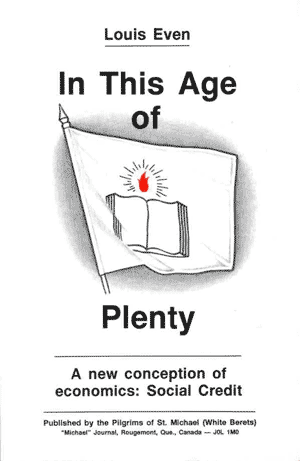
Preface to the 1946 French Edition
This book deals with Social Credit, but in no way does it sum up the matter. In fact, Social Credit is a whole new orientation given to civilization: It deals with social and political matters as well as, or more so, with matters of economics. We even believe, as Douglas did — to whom the world owes this enlightening doctrine — that rectifying economics along Social Credit principles, is impossible without first rectifying politics.
In this book, however, except for a few thoughts arising from the repercussions of a flawed and dominating financial system on politics, we have confined our study to the economic objectives and monetary proposals of Social Credit.
The title of the book — In This Age of Plenty — clearly shows that we are dealing with an economy of plenty, of an easier access to the immense possibilities of modern production.
“Old economics” could well have been found under the title of "The Age of Gold" or any other rare commodity, at a time when production itself often failed. But progress is ignored and logic is set aside when, to confer claims upon an automated production, we insist on keeping an instrument linked to scarcity.
 Louis Even Louis Even |
In the first part of this book, we recall essential and very simple notions that are readily admitted by everyone, but which are almost totally ignored by the present economic organism. The ends no longer direct the means. A brief study of the present monetary system shows that money governs where it ought to serve. We offer the Social Credit proposals as a remedy, giving an outline without going into the methods of implementation. The problem, we believe, lies not so much in developing an operational technique, but in getting people to agree on proposals that seem both too simple and too bold to the minds of those who are used to losing sight of the ends and to getting bogged down in the complexity of the means. Therefore, several chapters are meant to be a plea in favor of the Social Credit doctrine.
The second part is made up of reprints of speeches and articles that are likely to shed light on different aspects of Social Credit.
In offering this book to the public, we have set our sight on the average reader. Even when dealing with precise topics, we have done our best to avoid technical terms, since they are more likely to make the readers weary than to enlighten them. We have striven to write in such a way as to be readily understood by the largest number of people. This is in line with an economy of plenty at the service of all and everyone.
Montreal, May 1st, 1946.
LOUIS EVEN
Fifty years after its publication, Louis Even’s book "Sous le Signe de l'Abondance" is now available in English. Today, throughout the world, there are as many subscribers to his Movement’s English-language periodical, Michael, as there are to its French counterpart, Vers Demain. Details on the development of Louis Even’s Social Credit Movement can be found in the biographical notes.
"In this Age of Plenty" is the English translation of the fourth revised and enlarged French edition published in 1988. Ten chapters and six appendices, mostly articles that were published in the Michael Journal since, have been added to the 1988 edition.
In This Age of Plenty published in Polish
Bishop Kraszewski
 Bishop Kraszewski Bishop Kraszewski |
 Louis Even’s book, “In This Age of Plenty”, was published in Polish in 1993 by Bishop Zigniew Jozef Kraszewski, then Vicar General of the Diocese of Warsaw-Prague, Poland. (Note: Bishop Kraszewski died on April 4, 2004.) Here is the translation of the preface to Louis Even’s book, written by Bishop Kraszewski:
Louis Even’s book, “In This Age of Plenty”, was published in Polish in 1993 by Bishop Zigniew Jozef Kraszewski, then Vicar General of the Diocese of Warsaw-Prague, Poland. (Note: Bishop Kraszewski died on April 4, 2004.) Here is the translation of the preface to Louis Even’s book, written by Bishop Kraszewski:
“What Catholics learned in the social doctrine of the Church is the way between socialism and capitalism. For many years, this doctrine has been diffused in Canada, and known as the Social Credit theory. Louis Even’s book, In This Age of Plenty, that I introduce to the Polish readers, is an exposition of the Catholic social doctrine that is good not only for the Canadians; this book contains a lot of instructive topics for any person who reads it and who is open to social problems. This book has not been written only for great theoreticians and scholars, but for everybody. That is why this book is precious to the Poles, especially at the time of the second miracle of the Vistula River that we are presently experiencing. (The miracle of the downfall of Communism.)
“Poland miraculously succeeded in gaining its freedom and sovereignty. After the devastation of Communism that had been keeping us captive for so many years, we have the duty to choose the right path of social justice, based on Catholic doctrine. I think this book will largely help in achieving that. I entrust all the readers to the protection of Our Lady Victorious, who reigns in the co-cathedral of Kamionku, in Warsaw.”
Preface to the 2017 Edition
Things have not improved much in Economics since Louis Even’s book, In this Age of Plenty, was written in 1946. It could even be argued that they have gotten worst for a lot of people while credit is being concentrated in the hands of fewer individuals.
Production is easier to make than it ever was. Yet, distrbution is lagging behind not because the means of distribution are lacking, but because the financial means do not reflect facts.
At a time when our most brilliant minds have come to realize that “workers are being left behind because of automation, globalization and progress” (Warren Buffett) while others are suggesting that we should “tax the work of robots” (Bill Gates) to help those who have lost their jobs to automation, it is high time that Louis Even be allowed to lead us a step further in our study of Social Credit Economics.
We have kept the first part of the book unchanged. It is a philosophical approach to Economics that clearly defines means and ends and how they must be applied to Economics.
The second part has been replaced by A Sound and Efficient Financial System. This is a 32 page document that was written in 1964 to explain how Social Credit might be applied.
A third part has been added. It contains some of the articles that were printed in part II of the previous English edition